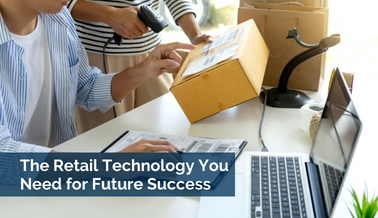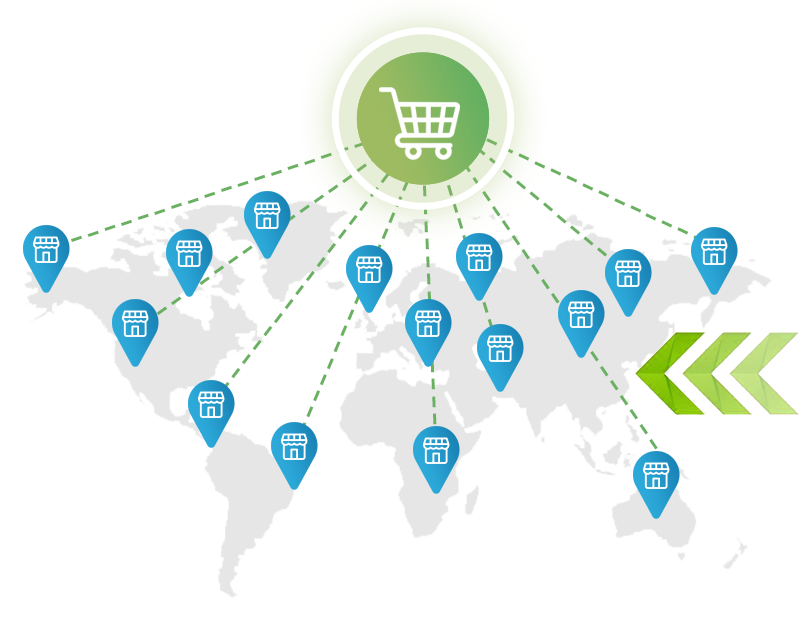The Retail Technology You Need for Future Success

September 14, 2022
Investments in omnichannel retail have been developing for years, with more companies looking to expand the technology they use to broaden their eCommerce activities. In fact, according to Shopify.com, 53% of brands are investing in tools to allow them to sell anywhere. This includes unifying online and in-store operations and adopting or developing global marketplaces to ensure a positive customer experience. As we head into oncoming economic headwinds, this focus will help streamline processes to offset costs and maintain an efficient supply chain.
The Big Picture
Research indicates that omnichannel operations will not be the differentiator for retail but that having unified commerce on the back end will. Unified commerce supports omnichannel sales by providing multiple ways to make a purchase and acquire goods, including data connectivity between those various avenues.
How often have you seen something “in stock” online only to find out that it’s not in stock at the store or that it’s only offered in certain styles or sizes? This is where having integrated and accurate data across systems is critical.
As suppliers are seeing demand and supply chain snags increase, retailers are taking a closer look at inventory visibility and focusing on accuracy. Knowing with certainty what inventory is available on-hand or where particular goods are within transport plays a major role in strengthening consumer confidence as they make buying decisions.
One of the most essential processes in retail is the order-to-cash cycle, encompassing order management, fulfillment, delivery, and payment by consumers or between businesses. Automation is key to getting ahead of supply chain friction and increasing speed to market. Using data from multiple channels, you can determine the ROI of different strategies and streamline processes for a shorter cycle.
As retail moves forward, everyone is being asked to do more with less — less staff, less budget, and less time, but with the expectation of more extensive and meaningful results. Let’s take a look at three fundamental retail technologies that have been developed to help retailers meet expectations despite having fewer resources.
Popular Technology for Modern Retail Trading
1. Drop Shipping
Drop shipping is one of the many fulfillment models that retailers are deploying to help manage their distribution. In the drop shipping model, retailers market and sell products on their digital platforms, like social media marketplaces or eCommerce storefronts. However, the fulfillment of the orders falls to the manufacturer. The manufacturer gets exposure and increased sales opportunities, and the retailer doesn’t need to worry about inventory investments and management; it’s truly a symbiotic business relationship.
Especially in today’s market, drop ship presents various challenges to ensuring that the customer promise is kept. First and foremost, outsourcing fulfillment to a supplier can pose some difficulties around visibility, tracking, tracing, and the basic order flow between the supplier and the retailer.
Getting correct, real-time inventory positions, especially when running a drop ship program with numerous vendors, is also tricky. Here, automation and integration help to ensure you’re getting those positions regularly. By integrating both EDI and eCommerce, retailers can automatically update inventory on product listings based on incoming supplier data, and consumers can see exactly which products, in whichever size/color/style, are available without worrying about an “oops” email post-purchase. This ensures that the end consumer is confident that they will have the product when they want it.
2. EDI (Electronic Data Interchange)
Electronic Data Interchange (EDI) is a system or method for exchanging business documents with trading partners. These can be your suppliers, customers, carriers, 3PLs, or other supply chain connections. In 2019, EDI accounted for more than 78% of B2B electronic sales, making it the most popular method for B2B transactions.
Traditional retail trade relationships rely on slow, manual processes to transfer document types like purchase orders, advance ship notices, and invoices. Not only do these manual processes put a strain on your team, but they also reduce your supply chain visibility and order processing speed. EDI optimises these business processes by replacing manual data entry tasks with electronic exchanges of business documents.
EDI provides the scalability and speed you need to grow your business by automating data exchange between business systems. It also lets brands meet compliance requirements for retailers and distributors to ensure every outgoing document has complete data in the correct format, making it essential for sustained competitiveness and growth for retail businesses of any size.
3. API (Application Programming Interface)
In addition to globally leveraged connection methods like EDI and eCommerce portals, APIs are becoming increasingly popular among retailers. APIs, or Application Programming Interfaces, are uniquely developed software connections between systems built to execute a series of operations or functions. The uses for APIs can range widely, but for retailers, they can be developed to meet specific connectivity and trading requirements and may offer increased flexibility as a result.
Retailer API requirements can feel intimidating for suppliers, especially those already using supplier portals, eCommerce options, EDI, and other file transfer methods. One step towards success is to leverage API integrations, which provide the “bridge” between a supplier’s ERP system and the retailer’s API. But to truly succeed in managing all these connectivity methods, suppliers should consider investing in a unified commerce platform. For example, Wayfair suppliers can use an API integration to create a direct connection with the Wayfair platform. This provides improved data accuracy, faster order processing, and lower operational costs.
These technologies and integrations allow retailers and suppliers to collaborate more effectively and provide ideal customer shopping experiences. This ideal drives the automation and innovation needed to not only serve the retail industry, but all industries as we move forward.
About the Author: Peter is Vice President of Product Management-Retail with over 25 years of experience helping organisations in Retail and CPG leverage B2B integration throughout their supply chain by using data standards and technology to automate complex order and fulfillment processes. Peter is actively involved in industry trade and standards groups such as NRF, GS1, and RVCF. In addition, he is currently an advisory board member of the Center for Supply Chain Research at Lehigh University, where he actively participates in industry research. Peter is a veteran of the U.S. Navy and attended Central Texas College and Embry Riddle Aeronautical University, where he studied aviation and business management.
Share this post:
Categories
Stay ahead of the competition
Get expert supply chain insights delivered directly to your inbox weekly.
